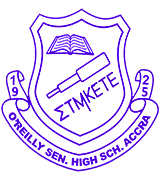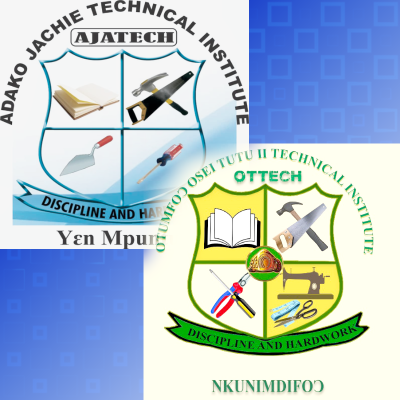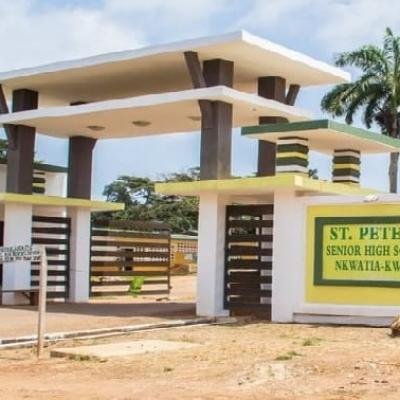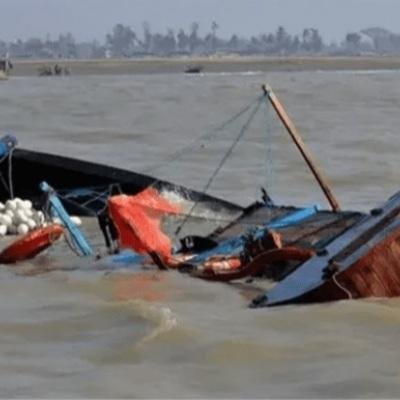History of O'Reilly Senior High

Foundation of the Educational Institute
Rev. Ezekiel Festus O’Reilly, a Sierra Leonean Anglican Priest, established the O’Reilly Educational Institute (as it was first known) in August 1925. The school’s first home can still be seen in the area known as Korle Wokon, north of Ussher Town. Here, Barrister Silas Dove, Rev. O’Reilly’s first sponsor, had a large house opposite what was then the Full Swing Factory at the north end of Zongo Lane. He incited Rev. O’Reilly to use the basement of his home as a starting place for the new school.
On August 1, 1925, the O’Reilly Educational Institute was officially declared open. So began, in the words of the Hon. A. J. Dowuona-Hammond, “the 4th oldest Secondary School in Ghana… founded with the sole aim of providing education for ambitious lads of poor parents.” It was to provide a complete course of education, lasting twelve years, from the infant school to the school-leaving examination. Naturally, the Kindergarten section was the first to be established in 1925. Amazingly enough, there may have been nearly 200 little children attending the school by 1927, and at the beginning, the school had very few teachers.
The Move to Tudu
Unlike many educationalists of his time, Rev. O’Reilly refused to remain satisfied with unsuitable and overcrowded housing for his school. Thus, in 1926, he decided to undertake a fundraising tour through the Gold Coast (now Ghana) and Nigeria. He also received much financial help from his fellow Sierra Leoneans who lived in Accra. They included a third member of the Dove family, Dr. Horace Dove; Roland Martyn; H. A. Sackeyfio, the father of C. O. M. Sackeyfio, who taught at O’Reilly from 1930; T. Warburton; and Gbami Cole, who owned the house where O’Reilly himself lived in the early years – Mary Villas, in the Horse Road. After the school had been founded, these gentlemen formed themselves into an unofficial group of supporters, with whom the Headmaster used to discuss administration problems.
This project turned out very successfully, and he then started to look around for a new site. Fortunately, he had become acquainted with Francis Dove, the elder brother of his first sponsor, Silas Dove. Through this relationship, Rev. O’Reilly was given a large plot of land near his residence. Here, the new buildings went up on the road, leading eastwards from Boundary Road towards what is now Accra Technical Institute (ATU). The construction of the school ended up as a self-help and private initiative; once a week, a contingent of pupils and teachers would march over to the new site and turn themselves into unpaid labourers, clearing and leveling the site, making up concrete, carting timber and roofing about. Rev. O’Reilly himself could be seen mixing mortar and wielding a trowel. By the end of the year, this volunteer force had put up the unpretentious but solidly built classrooms.
Once established at Tudu, Rev. O’Reilly felt free to set up the preparatory and secondary departments to take children from the Kindergarten classes that started at Korle Wokon. So, the school offered a complete course from the Nursery to the School Certificate. Three years were to be spent in the Kindergarten, three in the Preparatory, and six in the Secondary Department. From the beginning, the school was co-educational, and it can claim to have been the first in Accra to have successfully prepared a girl for her Junior Cambridge Certificate.
Staff and School
One of the greatest problems facing Headmasters as of then was a shortage of qualified staff. But Rev. O’Reilly was fortunate to have the assistance of four compatriots: Messrs. Leigh, Sackeyfio, Acquah, and Rev. J. C. T. Beccles. One of the many Ghanaian teachers was also Mr. Paul Tagoe, who later became the Regional Commissioner for Greater Accra.
As was common practice in those days, pupils of the Secondary department worked as teachers in the Kindergarten. There were usually seven or eight of these lady teachers for many years under the command of Miss Harriet Bruce. Later, one of these teachers was yet another Dove, Miss Marie Anne Dove, who was also the Assistant Organist.
Politics and Education
Old Boys of O’Reilly Educational Institute who worked their way up to respectable positions in the civil service included: Mr. Mahama Suka, who was trained in the school during the 1930s and passed his School Certificate and was the first Hausa boy to do so in the then Gold Coast; Mr. P. Opare Addo of the Survey Department; Mr. Isaac Vanderpuije of the Foreign Service; Dr. Ayeh-Kumi who was appointed Consultant on General Economic and Industrial Matters to the President; Hon. A. J. DowuonaHammond, Former Minister of Communications; Mr. E. A. Mettle-Nunoo, Former Chairman of the Graphic Corporation; Mr. E. H. T. Korboe, Former Eastern Regional Commissioner; Mr. Cecil Forde, one-time Secretary of the Convention People’s Party (CPP) and Former Chairman of the Ghana Radio and Television Corporation.
The Lean Years
Rev. O’Reilly died in harness, on the morning of January 5, 1944, without making any provision for a successor. The school was thus taken over by his nephew, Mr. E. L. L. Wright, who did not qualify for the teaching field apart from what he claimed to have been a “Full Secondary Education”. But he took his duties seriously.
Unfortunately, he faced difficult problems, including financial problems, since he did not have the backing of generous and influential friends such as Rev. O’Reilly himself had enjoyed.
Plans for Government Assistance
When Dr. Nkrumah formed his first Government in 1951, he put forward a revised and expanded Development Plan, out of which the then Minister of Education, Mr. Kojo Botsio, introduced an Accelerated Plan of Educational Development, which was approved by the assembly in August. The plan laid down that Secondary Schools of a certain standard should become known as Encouraged Schools and have their teachers’ salaries and “certain approved expenses” met by the Government.
Ten schools were recognized as “Encouraged”, including O’Reilly Educational Institute. They were not yet in the same category as the Assisted Schools. Unfortunately, the “certain approved expenses” did not include new school buildings, and finally, it was decided that nothing could be spent on developing these schools until 1956. As a result, they grew slowly over the years.
Fortunately, in 1958, the Encouraged Schools began to receive the same type of help from the Ministry as the Assisted Schools, so their name, indicative of a special status, became obsolete.
Preparing to Grow Up
Meeting on March 3, 1959, the Headmaster and Governors decided that the school’s name should be changed to suit its new status as a fully Assisted school. So, on October 20, 1959, the name was changed to O’Reilly Secondary School. This change of title marked the beginning of growth and development.
The Accra Municipal Council, at last, found it possible to move the Primary School out of the Tudu site. So, at the beginning of 1960, two streams were enrolled. A small Preparatory department continued to function for children who needed extra coaching before entering the Secondary School, with no more than twenty (20) pupils. The Primary School classrooms, however, did not measure up to the standards required by Secondary School students, even when decorated and brightened up. So, the Governors began looking around for a new building that would give more elbow room for expansion and better conditions for work.
Disagreements
In September 1959, the Headmaster traveled to the United States, and in his absence, it was discovered that the school’s accounts had been extremely carelessly kept for some years. In effect, the new Board of Governors suspended Mr. O’Reilly Wright in June 1960. During the times when Mr. Wright was away, Rev. Palmer stood in as the Acting Headmaster. But in March 1961, he was advised by his doctor to go on a one-month leave. During his leave, his place was temporarily filled by Mr. Ewusi, the next most senior member of staff.
The Move from Tudu
As soon as Mr. Ewusi was appointed to the vacant Headmastership at the end of the 1960-61 academic year, he began to pursue the aim of consistently making the school’s name well-known throughout the country. His energy had immediate results and by the next year, there were about 300 pupils on the roll.
The Tudu site could now not accommodate a much larger number with comfort, so the Board Chairman decided that the school would move into the buildings that the Accra Academy in Jamestown had vacated. This move eventually happened in October 1961.
The Move from Jamestown
Again, the population of the school was increasing, and facilities needed to be extended. The school, therefore, had to leave Jamestown into a rented premises at Kokomlemle.
The Move from Kokomlemle
Then again, around the mid-1980s, the landlord of the Kokomlemle premises ejected the school. This unfortunate action caused the school a massive loss of documents and properties. But by the grace of God, the school was able to settle in a 3 story-building structure just behind the Holy Spirit Cathedral at Adabraka.
The Final Move
In August 2010, the Ghana Education Service (GES) directed the school to stop accepting new entrants and prepare for closure. Hence, the infamous ‘O’Reilly kaput’; a caption in the Daily Graphic that indicated the closing down of the school. After twenty (20) years, the building’s owners housing the school had decided that since the Service could not afford to purchase the building, they would no longer lease it to them.
The story was cartooned with the school in a ‘boneshaker’ with the Headmistress sitting in front with teachers and students sitting at the back. It went on to say, “Buy the Headmistress, get a teacher and four students for free”. Though funny, it was a very sad moment in the life of the school.
Mrs. Mary Adu-Gyamfi, the then Headmistress of the school, however, fought so hard to stop the school from closure. She even went to the extent of looking for new land for the school when no action was being taken by the Service. Her efforts became successful when a contract was awarded in that same year for the construction of the school at Teshie. Finally, the school moved to its new and current location at Teshie Okpoi-Gonno in December 2010. The new building constructed to accommodate the students is good enough for teaching and class activity.
Remembrance
The school’s history cannot be complete without mentioning the following special people who dedicated themselves to making sure that O’Reilly was relocated:
Mrs. Mary Adu-Gyamfi of blessed memory, the then Headmistress of O’Reilly Senior High School who stood against all odds. The Board Chairman, Mr. A. Buenya; Hon. Amartey Mensah, who was the then M.C.E of LEKMA, currently the Board Chairman; Mr. Alpheaus Adjei, who worked at the National Achievers; Mr. R.F.T Nortey, a representative of the Nuumo Nmashie family, our present land owners; Rev. Kathleen Alottey, our Chaplain at the time; Mr. Emmanuel Neequaye; the dedicated old students; Brigadier General Nunoo Mensah, our benefactor; and some dedicated and committed members of staff like Mr. Laud Bekoe, who is now on retirement.
The administration of the school has set aside every first Wednesday in December, calling it “Remembrance Day”, to commemorate the special day on which the school moved to its property.







